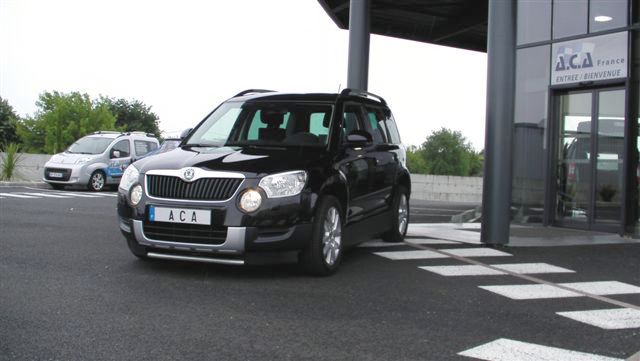
The Government is to look into why a minor transport body charged with approving ‘hobby’ projects like hot-rods has banned the use of NZ-built wheelchair-access vehicles that continue to be passed fit by independent authorities.

Associate Transport Minister Craig Foss has asked his officials to appoint an adjudicator to look into getting the self-drive cars back on the road. Transport Minister Simon Bridges and Disability Issues Minister Nicky Wagner are also in the loop.
The deadline brings executive attention to a two-year dispute between the company that built the vehicles and the Low Volume Vehicle Technical Association (LVVTA), a branch of the NZ Transport Agency that banned them. It comes soon after ACT leader David Seymour, a qualified engineer, checked out one of the vehicles himself.
There are 11 in all, converted Skoda Yetis (top) designed to be driven by the wheelchair-users themselves. They were built by U-Drive Mobility (UDM), a Waiuku-based operation owned and run by businessman Roger Phillips. The LVVTA at first approved them for use, but later banned them, claiming they didn’t meet LVVTA standards.

Wheelchair-users who had bought the vehicles were suddenly stranded. Three owners have died since the ban was imposed late in 2013. Since then, Phillips, the LVVTA and the NZTA have been butting heads while Phillips set up a plant in France to make identical vehicles for Europe. A French provincial government helped kick-start the operation with a 400,000 euro grant.
Phillips said Seymour rang him after being told of the stalemate with the NZTA. “He came out to the plant on a Sunday night, went over the Skoda, and left,” Phillips said. “That same night he sent me an email, saying he was particularly impressed with the vehicles, couldn’t understand why they had been banned, and that he would be asking government for an urgent inquiry.”
The inquiry is long overdue. There is anecdotal evidence of departmental duck-shoving, of ministerial staff being deliberately fed mis-information, of one transport department knowing very little of what the other one is doing. No one in the government’s transport sector will admit as much, but the LVVTA’s bungling of the UDM vehicles has annoyed its NZTA masters.
NZTA review aims to find out if a review is needed
The NZTA has confirmed it will review a branch of the LVVTA to see if a review of the branch of the LVVTA is needed. The branch is the Low Volume Vehicle (LVV), more a system than a branch.
The NZTA will also review the LVVTA, although it says it is doing no such thing. “We are not reviewing the LVVTA,” says NZTA executive Robin Elston. “As one of the participants in the system they (LVVTA) are naturally included in the wider review of the LVV systems and processes.”
Loosely, then, the NZTA review of the LVV includes a review of the LVVTA, because the NZTA is largely responsible for how the LVV works and what the LVVTA does.
So what is LVV? In a nutshell, it is a process put in place by the LVVTA and NZTA which vehicle certifiers follow. The LVVTA trains and monitors the certifiers; the NZTA appoints the certifiers. The LVVTA? It was set up by the NZTA in the late 1990s to approve for use on NZ roads ‘home-built’ vehicles like hot-rods.
Elston said the review of the LVV would be broken into three phases: scoping, analysis and implementation, that is if implementation was required. She said: “We are currently working with a potential provider to finalise the terms of reference for the scoping phase.
“It is intended that this phase will provide the opportunity for all system participants, including customers, to identify pain points and areas that are working well. This information would be then used to determine any specific areas for review.”

The LVVTA has been up to its ears in controversy of late, especially since being accused of overstepping its hobby vehicle brief with UDM and Phillips. Another case in point: one of its LVV certifiers approved as roadworthy for NZ converted wheelchair vehicles later found to be dangerously faulty.
There were 90 of them, modified in Italy by the KIVI company, and bought by the Accident Compensation Commission in 2008 for $8.34 million. Then ACC claims executive Gail Kettle signed off on them. Kettle is now the claims manager for the Earthquake Commission.
Soon after their arrival in NZ a Tauranga engineer contracted to the ACC and NZTA found most of them were unsafe. What happened to them? They got shoved here and there for five years until the LVVTA was told to have them fixed.
It got Carterton company Braiden International to do the work. Braiden says it worked on 50 of the 90, to repair sloppy Italian workmanship, including structural problems the Tauranga engineer years earlier said would surface to bite the ACC, LVVTA and NZTA on the backside.
The ACC and NZTA should have hired a qualified structural engineer to inspect the vehicles in Italy before the ACC’s Kettle signed the $8.34m cheque. Instead, the ACC sent a LVV certifier, who was wined and dined by KIVI’s public relations people and never got to check out the NZ-bound shipment until it landed here.
